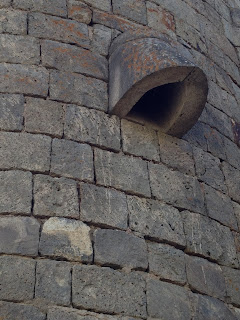The monastery at Tatev became a travel objective as soon as I read it was accessible mainly by the world's longest cable car ride. I figured this had to be REMOTE, which seemed appealing. I was not disappointed.
 |
| View from the cable car |
You can get to Tatev by car, but the road is in very poor condition and takes quite awhile to drive down the gorge and then back up the gorge on innumerable switchbacks. A few years ago a wealthy Armenian businessman financed the construction of a cable car as an alternative. The car travels 5.7 km for about 12 minutes, giving a very smooth ride in an enclosed glass car holding perhaps as many as 15 people. Built by a Swiss company (lots of reassurance from that!), it can operate in winds up to 80 km/hour. Happily the day we visited the winds were only 12 km/h. And best of all, we were in the first cable car to arrive that day, meaning we and 13 of our closest friends (Australians on a 45-day silk road tour from Beijing to Istanbul) were alone there for at least 30 minutes.
 |
When you board the cable car, Tatev is not within sight. You pay about $10 for a round trip ticket going on faith that something interesting is out there. Turns out Tatev is two or three valleys away and only comes into view on the last leg of the cable car trip. Then you gasp at the view of this enclave perched on the edge of a gorge.
Some say Tatev is best seen like this--from afar--but I loved being on the ground within the walls just as much. It seemed to me, as I wandered in and out of the Father Superior's Quarters and other buildings that make up the compound, that new windows on the world presented themselves in every room. Views of the outside world change from a mountain stream far below to distant farmland, to mountains-- your perspective changes, depending on where you are...sort of like life.
 |
| View through a small arch near the gate. |
 |
| View southeast from monks' quarters |
 |
| The mountain stream as seen from the Father Superior's quarters |
 |
| "Need bread and milk soon!" |
 |
| Sts Peter and Paul Church |
 |
| Gavasan gave early warnings of earthquakes |
 |
| Tomb of Grigor Tatevetsi |
 |
| Land surrounding the compound |
 |
| Ancient oil press produced walnut oil. |
In the sanctuary of the Church of Sts Peter and Paul, in the center of the walled enclave, we happened upon a religious observance. Two priests were chanting, ringing bells, and swinging a thurible filled with smoking incense. Sunlight was streaming in from the southeast windows, lighting up the dust motes and incense smoke in the air. Only a few people were in the building, some lighting candles, others simply standing and listening to the ancient rituals. When they left, most walked backwards away from where the priests were carrying out the liturgy. Out of tradition from the time my brother was undergoing a stem cell transplant in 2006, I lit a candle for Bill and prayed for peace.
All of Tatev inspires respect of this sort. Seen in the bright sun of late morning, with few others around, it was not impossible to imagine the contemplative life lived for centuries in this place, so far and so difficult to reach by either friend or foe. It is no wonder that until recently this beautiful place was rarely visited.
In the past two years since the cable car operation began, the number of visitors to Tatev has increased exponentially. It is now becoming a destination wedding site, with a huge semi-permanent white structure (think fancy wedding ten but more substantial-looking) close to the parking lot and cable car platform and overlooking the steep mountains and long valleys. The day we visited the builder of the cable car was expected to arrive by helicopter for a visit so the whole upper parking lot had to be cleared for use as the heliport. Word has it he is thinking of building a second cable car which would link to some remote second homes nearby. Things are definitely substantially changing at Tatev after a millenium of quiet witness.


No comments:
Post a Comment